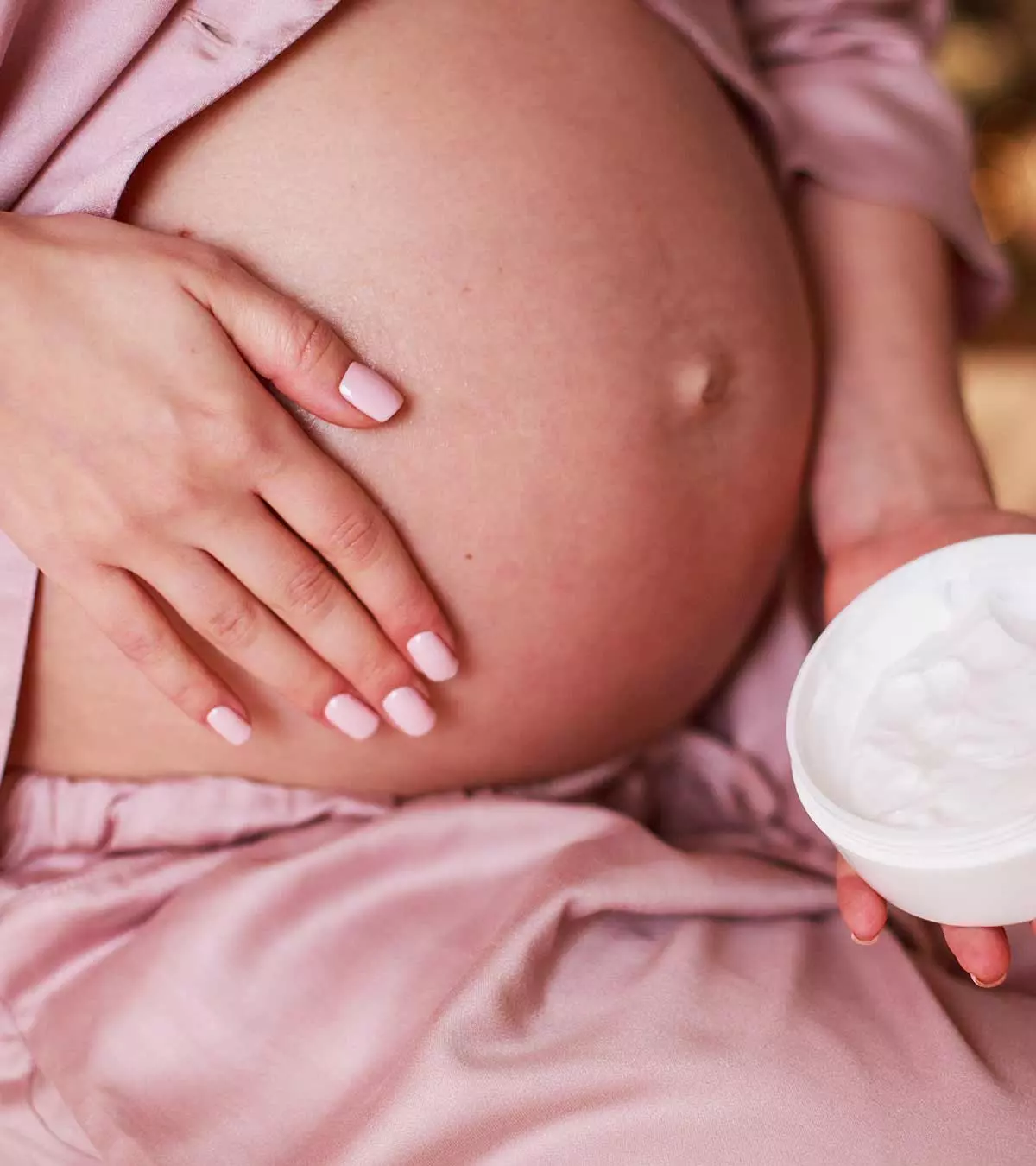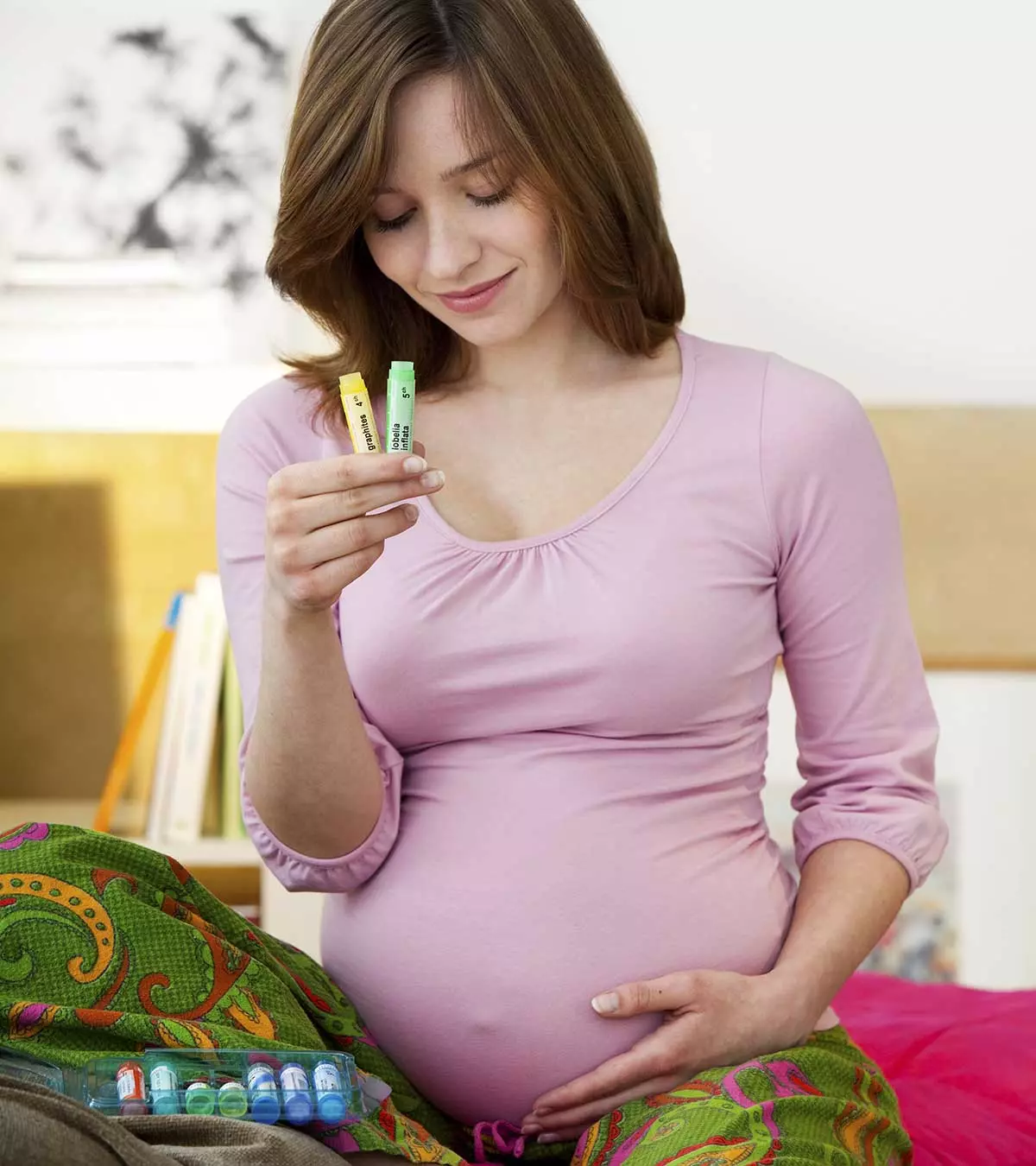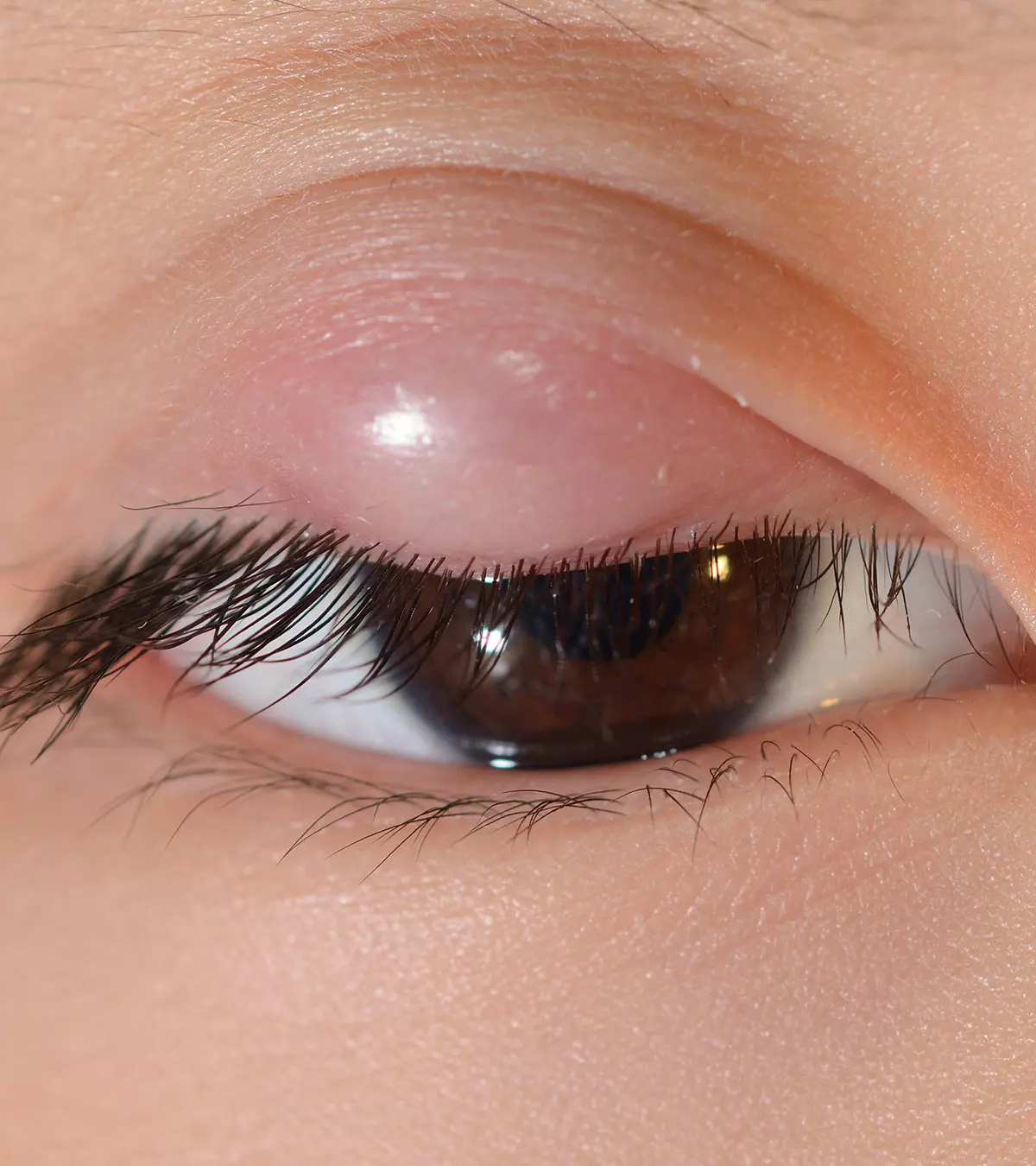
Image: Shutterstock
Skin darkening during pregnancy is a commonly observed phenomenon. Also known as hyperpigmentation, skin darkening occurs in the form of patches or patterns on the skin. Some common places where you might notice these patches include the linea nigra (a dark line moving across the belly), melasma (patches on the face), chloasma (patches on cheeks, upper lip, forehead, and chin), and the darkening of the areola (1). These marks are more prominent in those with dark-colored skin. This condition may also lead to the darkening of birthmarks, freckles, or scars during pregnancy. Read on to learn more about the causes, treatment, and prevention of skin darkening during pregnancy.

Key Pointers
- Hyperpigmentation in certain areas such as the areola, face, and belly may result from an increase in hormones during pregnancy, excessive sun exposure, heredity, or hyperthyroidism.
- The risk of skin pigmentation can be reduced by using sunscreen lotions and moisturizers, taking folic acid, and avoiding waxing.
- Lemon juice, aloe vera, turmeric, potato extract, orange peel, and yogurt are some home remedies that can help exfoliate the skin and manage pigmentation.
- Melasma may fade automatically post-pregnancy once hormone levels return to normal and may recur only during subsequent pregnancies.
What Causes Skin Darkening During Pregnancy?
Many women experience skin changes, such as stretch marks, acne, or dark spots during pregnancy (2). The exact cause of skin darkening or skin discoloration in pregnancy is not entirely known. It is often attributed to increased levels of certain hormones during pregnancy such as estrogeniA sex hormone produced by the body that facilitates sexual and reproductive development , progesteroneiAn endogenous steroid sex hormone that regulates the menstrual cycle, pregnancy, and other hormonal functions in women , and melanocyteiPigment cell that produces melanin -stimulating hormones (1). Also there is stretching of skin leading to aggravation of these changes. Research highlights that around 15% to 50% of pregnant women have melasma (3).
Some other factors that may also increase the possibility of skin darkening (or melasma) in pregnancy are (1) (4):
- Environmental factors such as UV radiation
- Pre-existing conditions such as hyperthyroidism (overactive thyroid)
- Heredity (if melasma runs in the family). Research shows that skin darkening is common in people with darker skin tones, primarily in those of East Asian, Southeast Asian, and Hispanic origins (5).
When Does Skin Darkening/ Discoloration Happen During Pregnancy?
More than 90% of pregnant women experience some sort of skin changes (6). The increasing estrogen and progesterone levels may contribute to increased melanin production (7). It might start as early as the first trimester.
- Starting from the first trimester, you may notice the darkening of the areola, and genital regions.
- Linea nigra may become noticeable in the second trimester.
A blogger who goes by the name DPrincess28 faced skin-darkening issues during pregnancy. Sharing her experience, she elaborates, “For me, I didn’t experience darkening on my face or neck. Instead, my belly became dark, as did some of the skin around my thighs and buttocks (i).”
All of these usually resolve in a few months after delivery (6). However, some of these may remain forever although in a lighter tone.
How To Reduce Pigmentation During Pregnancy
Skin changes usually disappear after delivery. However, you may take some measures to minimize the darkening of the skin in pregnancy.
- Protect yourself from strong sun rays: Exposure to the sun is one of the most significant factors that trigger pigmentation. Use a broad-spectrum sunscreen that has an SPF of 30 or higher as a part of your everyday skin routine. When going outdoors, cover yourself with a long-sleeved dress and a wide-brimmed hat (8).
- Take enough folic acid: Skin changes may also occur due to folateiAlso known as vitamin B9, it is mainly responsible for producing red and white blood cells in the body deficiency. Therefore, make sure you are getting enough of it either from your diet or through supplements (9).
- Do not wax: Although waxing is likely to be safe during pregnancy, it may cause skin inflammation that could worsen melasma. Therefore, do not wax the areas that are prone to pigmentation (10).
- Use hypoallergeniciA product with the least amount of allergy-inducing components skincare products: Choose cleansers, moisturizers, or face creams that will not burn or irritate your skin and worsen melasma (10). Topical corticosteroids may also help in fading pregnancy melasma.
You may not be able to prevent the uneven skin tone caused by pregnancy. You may consult a dermatologist if it gets severe. Using a good moisturizer throughout pregnancy over these sensitive areas may also reduce the severity of these marks and skin damage. Eating healthy foods and drinking plenty of water is important to support skin health. Additionally, getting enough sleep and engaging in gentle physical activity may contribute to healthier skin (11).
Home Remedies To Manage Skin Darkening During Pregnancy
Here are some home remedies that have been traditionally in use to lighten the dark patches on the skin. Most of the uses are anecdotal. Before trying any new remedy, consult a healthcare provider or dermatologist to ensure safety. A patch test is recommended before full application to ascertain suitability.
1. Lemon
Lemon juice has skin bleaching properties and could help reduce dark spots and blemishes (12).
How to use:
Dilute two tablespoons of lemon juice in some water. Dip cotton into the solution and apply it over the affected skin region. Leave for sometime before washing it off.
2. Turmeric
Curcumin, a polyphenol compound in turmeric, is reported to suppress the activity of melanocytes (13).
How to use:
Mix raw turmeric paste with lemon juice. Apply the mixture to the skin and allow it to dry. Wash off with water.
3. Potato
Azelaic acid content in potato is found to reduce pigmentation and spots (14).
How to use:
Grate one raw potato, squeeze the juice or apply it directly to the affected skin. Allow it to dry and wash with lukewarm water.
4. Aloe vera
Aloin, an active ingredient in aloe vera, is known for its skin-lightening properties (15).
How to use:
Apply freshly peeled aloe vera gel to the pigmented skin areas before going to bed. Rinse it in the morning using warm water. Continue using it until you see a noticeable difference in your skin color.
 Did you know?
Did you know?5. Soy
The isoflavonesiA type of phytoestrogen found exclusively in plants and known for mimicking the estrogen hormone , fatty acids, and trypsiniAn enzyme that aids in the breakdown and digestion of protein inhibitors in soy have been found to inhibit melanogenesisiThe term used for the production of melanin by melanocyte and trypsin and help reduce hyperpigmentation (15).
How to use:
Mix soy milk, lemon juice, and tomato pulp. Apply the paste to the pigmented skin areas and massage for a few minutes. Allow it to dry and rinse it.
6. Orange peel
One study has shown that orange peel extract is effective in whitening the skin (17).
How to use:
Mix orange peel powder, milk, and honey. Apply the paste to the pigmented skin areas and leave it to dry. Rinse with water.
7. Yogurt
Alpha-hydroxy acids in yogurt are usually used in superficial skin peeling. Yogurt contains glycolic acid, lactic acid, and citric acid that may help reduce skin pigmentation (18).
How to use:
Mix yogurt, honey, and finely ground oats in equal proportions. Apply the paste to the pigmented skin areas. Allow it to dry and rinse with warm water.
8. Pomegranate
Pomegranate contains ellagic acids that are likely to prohibit melanin production and lighten the darkened skin (19).
How to use:
Mix pomegranate juice with bentonite clay and apply the paste to the pigmented skin areas. Leave it to dry and rinse with warm water.
9. Cranberries
Arbutin, a compound found in cranberries, is known to inhibit melanogenesis (20).
How to use:
Blend some cranberries along with cinnamon powder and honey. Apply the paste to the affected skin areas. Allow it to dry and rinse.
 Quick tip
Quick tipWhen Does Your Skin Get Back To Normal?
Pregnancy skin changes such as dark patches, blotches, and lines tend to fade away after delivery as the hormone levels go down. In some cases, melasma which is also known as ‘pregnancy mask’ may recur in subsequent pregnancies or on the use of contraceptives (21).
Frequently Asked Questions
1. Does the dark neck go away after pregnancy?
Melasma may also affect the neck region. However, if it has occurred during pregnancy, then it is likely to fade away a few months after childbirth (22).
2. Does skin darkening affect my baby?
No, skin darkening has not been found to be associated with any adverse fetal outcomes.
3. Can low iron cause skin darkening in pregnancy?
Some studies suggest low iron may be associated with melasma. A study report states, “The higher frequency of below normal range of ferritin and serum iron levels in women with melasma compared to the control group showed a possible association between these serum parameters and melasma (23). However, more research is required to support the findings.
4. Does folic acid make my skin darker?
According to Dr. Anna H. Chacon, a board-certified dermatologist from Miami, Florida, “There is no scientific evidence to suggest that folic acid has any effect on skin pigmentation. However, changes in the skin due to deficiencies in folic acid levels are often characterized by paleness, attributed to anemia.”
5. Does skin darkening during pregnancy reveal the baby’s gender?
In some cultures, people relate skin pigmentation or pregnancy glow to the baby’s gender. However, there is no scientific evidence to support this.
Pregnancy hormones can be the reason for hyperpigmentation or skin darkening during pregnancy. In addition, environmental factors such as sun exposure, pre-existing diseases such as hyperthyroidism, and hereditary factors may increase the risk of developing darker skin in pregnancy. Hyperpigmentation can be more evident in the areola of the breasts and genital areas. A dark line called linea nigra can also appear along the abdomen during pregnancy. Avoiding waxing and sun exposure and taking prenatal vitamins such as folic acid may reduce skin darkening in pregnancy. These pigmentations tend to fade after delivery as the hormones decline without any specific treatments.
Infographic title: Hyperpigmentation Other Than During Pregnancy
Apart from pregnancy, hyperpigmentation may occur due to several other factors. Take a look at this infographic to know the causes, diagnosis, and treatment of hyperpigmentation in cases other than pregnancy. Illustration: Momjunction Design Team
Illustration: Home Remedies To Deal With Skin Darkening During Pregnancy

Image: Stable Diffusion/MomJunction Design Team
Pregnancy can cause skin darkening, but don’t worry! There are some simple methods to deal with it. Learn home remedies to treat skin darkening in this video. Get tips on natural ingredients to lighten your skin safely.
Personal Experience: Source
MomJunction articles include first-hand experiences to provide you with better insights through real-life narratives. Here are the sources of personal accounts referenced in this article.
i. Pregnancy & skin.
https://glorycrown.blogspot.com/2010/09/skin_17.html
References
- Anthony Massinde et.al; (2011); Extensive hyperpigmentation during pregnancy: a case report.
https://pmc.ncbi.nlm.nih.gov/articles/PMC3183040/ - Pregnancy and Skin Changes.
https://www.hopkinsmedicine.org/health/conditions-and-diseases/staying-healthy-during-pregnancy/pregnancy-and-skin-changes#:~:text=shortly%20after%20delivery.-Dark%20spotsyou%20spend%20in%20the%20sun. - Melasma.
https://www.ncbi.nlm.nih.gov/books/NBK459271/ - Ana Carolina Handel et.al; (2014); Melasma: a clinical and epidemiological review.
https://pmc.ncbi.nlm.nih.gov/articles/PMC4155956/ - Debabrata Bandyopadhyay; (2009); Topical Treatment Of Melasma.
https://pmc.ncbi.nlm.nih.gov/articles/PMC2807702/ - Rita V Vora et.al; (2014); Pregnancy and Skin.
https://pmc.ncbi.nlm.nih.gov/articles/PMC4311336/#ref3 - Melasma.
https://my.clevelandclinic.org/health/diseases/21454-melasma - Melasma (chloasma).
https://www.health.harvard.edu/a_to_z/melasma-chloasma-a-to-z - Nutrition and Lupus: How to Maintain a Healthy Diet.
https://www.hss.edu/conditions_nutrition-and-lupus-healthy-diet.asp - Melasma: Self-care.
https://www.aad.org/public/diseases/a-z/melasma-self-care - Leilei Zhao et.al; (2025); Prevention of Melasma During Pregnancy: Risk Factors and Photoprotection-Focused Strategies.
https://pmc.ncbi.nlm.nih.gov/articles/PMC11490249/ - Nico Smit et.al; (2009); The Hunt for Natural Skin Whitening Agents.
https://pmc.ncbi.nlm.nih.gov/articles/PMC2801997/ - Cai-Xia Tu et.al; (2012); Curcumin inhibits melanogenesis in human melanocytes.
https://pubmed.ncbi.nlm.nih.gov/21584871/ - M. Umadevi et.al; (2013); Health Benefits and Cons of Solanum tuberosum.
https://www.plantsjournal.com/vol1Issue1/Issue_jan_2013/3.pdf - Rashmi Sarkar et.al; (2013); Cosmeceuticals for Hyperpigmentation: What is Available?
https://pmc.ncbi.nlm.nih.gov/articles/PMC3663177/ - Jasmine C Hollinger et.al; (2018); Are Natural Ingredients Effective in the Management of Hyperpigmentation? A Systematic Review.
https://pmc.ncbi.nlm.nih.gov/articles/PMC5843359/ - N. Wuttisin et.al; (2017); Anti-tyrosinase activity of orange peel extract and cosmetic formulation.
http://www.ifrj.upm.edu.my/24%20(05)%202017/(40).pdf - Paula Souza Prestes et.al; (2013); Randomized clinical efficacy of superficial peeling with 85% lactic acid versus 70% glycolic acid.
https://pmc.ncbi.nlm.nih.gov/articles/PMC3900339/ - Su Jin Kang et.al; (2015); Inhibitory Effect of Dried Pomegranate Concentration Powder on Melanogenesis in B16F10 Melanoma Cells; Involvement of p38 and PKA Signaling Pathways.
https://pmc.ncbi.nlm.nih.gov/articles/PMC4632747/ - Jody P Ebanks et.al; (2009); Mechanisms Regulating Skin Pigmentation: The Rise and Fall of Complexion Coloration.
https://pmc.ncbi.nlm.nih.gov/articles/PMC2769151/ - Common Skin Conditions During Pregnancy.
https://www.aafp.org/pubs/afp/issues/2007/0115/p211.html - Melasma.
https://familydoctor.org/condition/melasma/ - Azadeh Goodarzi et.al; (2025); The association between melasma and iron profile: a case-control study.
https://romj.org/2025-0202#:~:text=Background%20%E2%80%94%20Melasma%20is%20a%20chronicanemia%20and%20vitamin%20B12%20deficiency.
Community Experiences
Join the conversation and become a part of our nurturing community! Share your stories, experiences, and insights to connect with fellow parents.
Read full bio of Dr. Rana Choudhary (Khan)

Dr. Anna H. Chacon is a board-certified dermatologist and author originally from Miami, Florida. She has authored over a dozen peer-reviewed articles, book chapters and has been published in JAAD, Archives of Dermatology, British Journal of Dermatology, Cosmetic Dermatology, and Cutis. An alumnus of Brown University, Dr. Chacon has over 7 years of experience and works as a tele dermatologist.
Dr. Anna H. Chacon is a board-certified dermatologist and author originally from Miami, Florida. She has authored over a dozen peer-reviewed articles, book chapters and has been published in JAAD, Archives of Dermatology, British Journal of Dermatology, Cosmetic Dermatology, and Cutis. An alumnus of Brown University, Dr. Chacon has over 7 years of experience and works as a tele dermatologist.
Read full bio of Rebecca Malachi
Read full bio of Swati Patwal
Read full bio of Aneesha Amonz


















